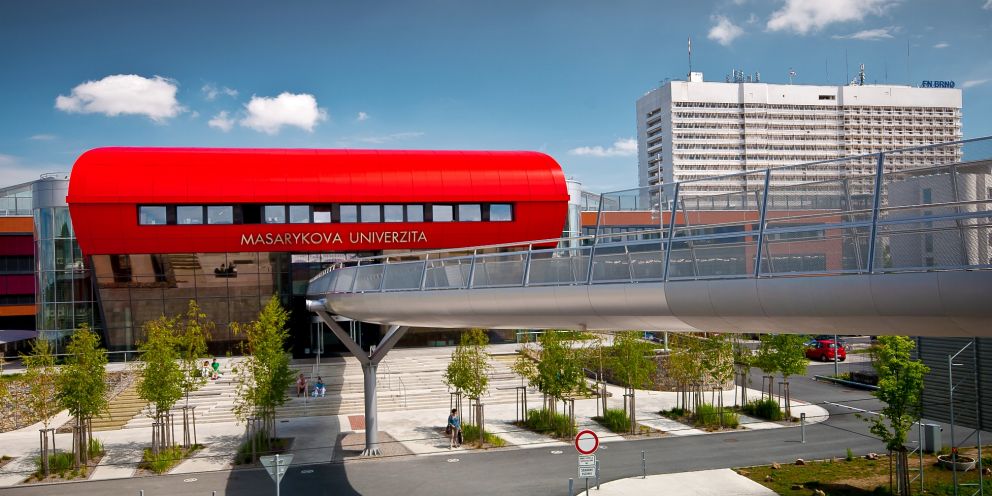Masaryk University: More than just science

The best public art is grounded in the place and community in which it is located. It interprets the history of the place and its people and may address contemporary social or environmental issues.
Last year, during a visit to the Masaryk University Bohunice campus, I discovered some great public art in the courtyards. Information was really difficult to find (p13). However, I was lucky enough to be introduced to Martina Šindelářová Skupeňová of the Masaryk University Language Center. She often takes students around the campus, using the sculptures as an educational tool, and offered to be my guide.
We started at the end of the walkway to the red building, where there is a bust of Tomáš Garrigue Masaryk himself. This is by Vincenc Makovský (1900-1966), a 1930’s progressive Czech sculptor and industrial designer who had strong links to the Brno area. Masaryk looks his usual distinguished self. Makovský’s other works in Brno include the statue at the entrance of the Brno Fairground, the Victory Monument at Moravské náměstí, and the bust of Eduard Babák, founder at the Medical Faculty at Masaryk University. This bust is also located on campus, in the courtyard of the Institute that is named after him.
Downstairs, I was shown the sculpture by Krištof Kintera (born 1973), called Red is Coming. Red viscous fluid flows from an outlet and solidifies on the floor. It is stunning in the red reception area of the campus.

The next stop on my tour was outside, in one of the courtyards. Reliefplastik is by Otto Herbert Hájek (1927-2005), the Czech-born German abstract painter, graphic artist and sculptor. This simple, cast-iron work is different from his more usual, highly coloured sculptures and designs for building facades and interiors. The rough, brown object is positioned in front of a smooth, high-gloss red wall. The contrast makes you think about naïve students being honed to smooth perfection (I think I might be getting carried away here).
My guide then took me to Contacts and Distance by the sculptor Aleš Veselý (1935- 2015). This is an astonishing work – a huge rock lightly held by a thin rod spanning a concave steel wall. The reflections change as you view the structure from different angles. Apparently the sculptor is interested in “exploring the tension of the masses and the activity of the elementary forces contained in the material”, but this work said so much more to me. Veselý is of Jewish origin and to me the sculpture evokes the burden of grief that the world carries for atrocities committed in the past – and today.
Most of the public art on campus is not owned by the University. While there was provision made in the original budget it went the way of all good things when the money ran out; so most of the works are on loan, hopefully, permanent loan. However there is one piece that was commissioned for the campus, Heyday of Intelligence by Vladimír Preclík (1929 – 2008) also translated as The Flowering of Learning. Preclík was trained as a stone mason, wood cutter, and wood carver and although this work is in bronze the influence of his early training is obvious.
At our next stop I thought the aliens had landed. Enlightenment and Heavy Paint by Lukáš Rittstein (born 1973) is a work in polycarbonate made by pouring resin into holes in the ground. When you realise that Rittstein is a committed anti-consumerist the meaning of the work becomes clear – no more aliens.
Jozef Jankovič (born 1937) is the only Slovak sculptor represented in the collection. Balance is a bronze cut-out of students coming home from a party. Jankovič was not allowed to exhibit during the socialist period so he worked on paper. The two dimensional nature of this work is suggestive of this earlier period.

Our last stop was in the foyer of the Morphology Centre of Medical Faculty in Masaryk University. Hanging high above the reception desk is The Nest, by Brno-based artist Dalibor Chatrný (1925-2012). Better known as a creator of situations (“happenings”) and a printmaker (some of his prints are hanging on the floor above), Chatrný has used stainless steel mesh to construct the nest. It’s a pity it’s hung where it is – you really want to get up close and personal with this work and you can’t.
Masaryk University has a long tradition of art collection, although the Faculty of Fine Arts is actually part of the Brno University of Technology. I hope that this fascinating collection becomes permanent so that people can enjoy this public art that has such meaning in its context.
Next time you are walking along the glass corridors of the campus, take time to look out the window and think about the sculptures. Or take your own tour using this blog post and a map (p14)!